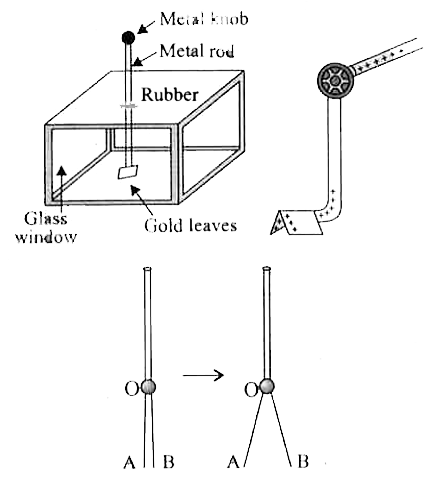ELECTROSCOPE
Step by step video & image solution for ELECTROSCOPE by Physics experts to help you in doubts & scoring excellent marks in Class 9 exams.
Updated on:21/07/2023Topper's Solved these Questions
- ElectricityBOOK - PEARSON IIT JEE FOUNDATIONCHAPTER - ElectricityEXERCISE - Short Answer
13 Videos
- ElectricityBOOK - PEARSON IIT JEE FOUNDATIONCHAPTER - ElectricityEXERCISE - Essay Type Qns
3 Videos
- ElectricityBOOK - PEARSON IIT JEE FOUNDATIONCHAPTER - ElectricityEXERCISE - Level 3
10 Videos
- GRAVITATIONBOOK - PEARSON IIT JEE FOUNDATIONCHAPTER - GRAVITATIONEXERCISE - LEVEL-3
10 Videos
Similar Questions
Akshay and Sauranh are the students of class IX. They have recently studied the chapter on structure of atom in the class. Both Akshy and Saurabh were performing some activities in the science laboratory. Akshy took a plastic comb and rubbed it in his dry hair. When he brought this plastic comb (rubbed in dry hair) near tiny pieces of paper, the comb attracted the pieces of paper towards it. Mean while, Saurabh took a glass rod and rubbed it with a piece of silk cloth. When he brought this glass rod (rubbed with silk cloth) near the tiny pieces of paper, the glass rod also attracted the pieces of paper towards it (just like the plastic comb). Akshy and Saurabh had studied an instrument called electroscope in class VIII. So, they decided to make use of a positively charged electroscope having diverged leaves (or opened up leaves) in their activity. Akshy took the plastic comb (rubbed in dry hair) and touched the metal top of positively charged electroscope with it. This made the diverged leaves of electroscope to fold up. Saurabh then tool the glass rod (rubbed with silk cloth) and touched the metal top of another positively charged electroscope with it. This made the diverged leaves of the electroscope to diverge (or open up) even more. Askshy did not understand the various conclusions which could be drawn from all these observations. Saurabh explained him everthing very clearly.
(a) What conclusion can be drawn from the observation that a plastic comb rubbed in dry hair and a glass rod rubbed with silk cloth, both attract tiny pieces of paper ?
(b) What do the above observations tell us about the atoms present on plastic comb and glass rod ?
(c) (i) What conclusion do you get from the observation that when a plastic comb rubbed in dry hair is touched with the metal top of a positively charged electroscope, then its diverged leaves fold up ?
(ii) What conclusion do you get form the observation that when a glass rod rubbed with silk cloth is touched with the metal top of a positvely charged electrosope, then its leaves diverage even more ?
(d) What are the two types of electric charges present in atoms as shown by the above observations ? Name the subatomic particles which carry these charges.
(e) (i) Which electric charges are agained by a plastic comb on rubbing in dry hair ?
(ii) Which electric charge are lost by a glass rod on rubbing with silk cloth ?
(f) What values are displayed by Saurabh in this episode ?
View SolutionIn an electroscope if a negatively charged body is brought in contact with the metal clip, the strips of the electroscope diverge. If now another charged object carrying equal amount of prositive charge is brought in contact with the clip, what will happen?
View Solution
Knowledge Check
A leaf electroscope is a simple apparatus to detect any charge on a body. It consists of two metal leaves OA and OB, free to rotate about O. Initially both are very slightly separated. When a charged object is touched to the metal knob at the top of the conducting rod, charge flows knob to the leaves through the conducting rod. As the leaves are now charges similarly, they start repelling each other and get separated, (deflected by certain angle).

The angle of deflection in static equilibrium is an indicator of the amount of charge on the charged body.
In an electroscope, both leaves are hinged at the top point O. Each leaf has mass m, length l and gets charge q. assuming the charge to be concentrated at ends A and B only, the small angle of deviation (θ) between the leaves in static equilibrium, is equal to :A(2kq2l2mg)1/3B(kq2l2mg)1/3C(2kq2l2mg)1/2D(64kq2l2mg)1/3A leaf electroscope is a simple apparatus to detect any charge on a body. It consist of two metal leaves OA and OB, free to rotate about O. Initially both are very slighty separted. When a charged object is touched to the metal knob at the top of the conduction re, charge flows from knob to the top of the conduction rod, charge flows from knob to the leaves through the conducting rod, charge flows from knob to the leaves through the conduction rod. As the leaves are now charged similarly, they start repelling each other and tet separted (deflected by certain angle).

The angle of deflection in static equilibrium is an indicator of the amount of charge on the charged boy.
If we perform these steps one by one.


In which case, the leaves will converge (come closer), as compared to the previous state?A(i)B(i) and (ii)Conly (iii)DIn all cases, the leaves will diverseWhen a negative charged rod is brought near, but does not touch, the initially unchanged electroscope shown below, the leaves spring apart (I). When the electroscope is then touched with a finger, the leaves collapse (II). When next the finger and finally the rod are removed, the leaves spring apart a second time (III). The charge on the leaves is
 Apositive in both I and IIIBnegative in both I and IIICpositive in I, negative in IIIDnegative in I, positive in III
Apositive in both I and IIIBnegative in both I and IIICpositive in I, negative in IIIDnegative in I, positive in III
